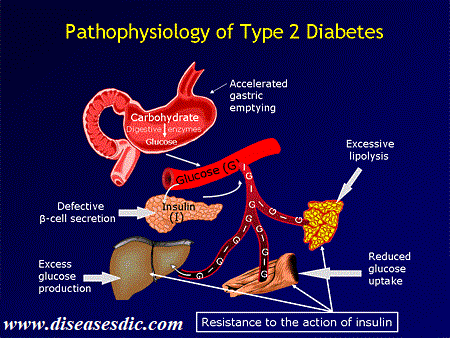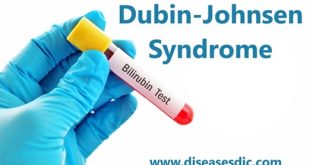Diabetes Mellitus Type 2 – Description
Diabetes Mellitus Type 2 is the most common type of diabetes. It is a chronic problem in which blood glucose (sugar) can no longer be regulated. There are two reasons for this. First, the cells of the body become resistant to insulin (insulin resistant). Insulin works like a key to let glucose (blood sugar) move out of the blood and into the cells where it is used as fuel for energy. When the cells become insulin resistant, it requires more and more insulin to move sugar into the cells, and too much sugar stays in the blood. Over time, if the cells require more and more insulin, the pancreas can’t make enough insulin to keep up and begins to fail.
Pathophysiology
Type 2 diabetes mellitus is often associated with certain genetic predispositions, environmental factors, lifestyle choices, and the dynamic interactions between all of these different aspects. This ailment is a disease state which involves the dysfunction of insulin-producing pancreatic beta cells, insulin hormone resistance in cells of the body, or a combination of both. Diabetes mellitus type 2 is a condition that typically begins with resistance to insulin by cells of the body that worsens over time. This resistance, and the compensating production of insulin by pancreatic beta cells may eventually lead to beta cell failure. When the beta cells fail, endogenous insulin can no longer be secreted.

Insulin resistance is the inability of cells to use the insulin hormone, which inhibits the cell’s capability to absorb and then use glucose in metabolic processes. This is of primary concern in cells that are typically high in metabolic function, such as muscle, liver, and adipose tissues. Since insulin is responsible for the cellular uptake of glucose, the sugar molecules will remain in the bloodstream.
The pancreatic beta cells, which are responsible for producing and releasing insulin, may also dysfunction in type 2 diabetes mellitus. If the insulin supply diminishes entirely, the individual will be dependent upon exogenous insulin.
Whether insulin is not present due to hyposecretion, or if the hormone is rendered useless because of insulin resistance, the end result will be hyperglycemia. Hyperglycemia, or elevated glucose levels within the blood, is the hallmark of type 2 diabetes mellitus. Hyperglycemia, and the associated inflammatory processes lead to the micro and macro-vascular changes that are seen as complications of diabetes mellitus.
What are the Causes of Diabetes Mellitus Type 2?
Type 2 diabetes – the most common form of diabetes is caused by several factors, including lifestyle factors and genes.
Overweight, obesity, and physical inactivity
You are more likely to develop type 2 diabetes if you are not physically active and are overweight or obese. Extra weight sometimes causes insulin resistance and is common in people with type 2 diabetes. The location of body fat also makes a difference. Extra belly fat is linked to insulin resistance, type 2 diabetes, and heart and blood vessel disease. To see if your weight puts you at risk for type 2 diabetes, check out these Body Mass Index (BMI) charts.
Insulin resistance
Type 2 diabetes usually begins with insulin resistance, a condition in which muscle, liver, and fat cells do not use insulin well. As a result, the body needs more insulin to help glucose enter cells. At first, the pancreas makes more insulin to keep up with the added demand. Over time, the pancreas can’t make enough insulin, and blood glucose levels rise.
Genes and family history
As in type 1 diabetes, certain genes may make you more likely to develop type 2 diabetes. The disease tends to run in families and occurs more often in these racial/ethnic groups:
- African Americans
- Alaska Natives
- American Indians
- Asian Americans
- Hispanics/Latinos
- Native Hawaiians
- Pacific Islanders
Genes also can increase the risk of type 2 diabetes by increasing a person’s tendency to become overweight or obese.
Risk factors that lead to Diabetes Mellitus Type 2
Type 2 diabetes is partly a genetic disease and partly a lifestyle disease. People whose parents had diabetes have a genetic predisposition, meaning they are more likely to get type 2 diabetes themselves.
While there is no single cause for developing Type 2 diabetes, there are well-known risk factors. Some of these can be changed (avoidable) and some cannot (unavoidable).
Unavoidable risk factors
The family history of diabetes – people with close relatives that have type 2 diabetes are more likely to get the condition themselves. Moreover one in ten of those with a sibling that has type 2 diabetes will develop the condition, as will half of those with an identical twin who is affected by type 2 diabetes.
- Age – the risk increases as a person gets older.
- Ethnic background – people from Aboriginal or Torres Strait Islanders, Pacific Islanders, Indian and Chinese ethnic background are more likely to develop type 2 diabetes mellitus.
- Having Polycystic Ovarian Syndrome or a history of gestational diabetes during pregnancy.
- Low birth weight is thought to predispose to diabetes due to poor beta-cell development and function.
Avoidable risk factors
- Obesity and overweight
- Physical inactivity
- High blood pressure
- Diet
- Impaired glucose metabolism
Manifestations of Diabetes Mellitus Type 2?
During the early stages of the disease, type 2 diabetes often doesn’t present any symptoms at all. Still, you should be aware of the symptoms and early warning signs, such as:
- Frequent urination and extreme thirst
- Sudden or unexpected weight loss
- Increased hunger
- Blurry vision
- Dark, velvety patches of skin (called acanthosis nigricans)
- Fatigue
- Wounds that won’t heal
Complications after Type 2 diabetes
The high blood glucose seen in diabetes can damage blood vessels, nerves, and organs, leading to a number of potential complications. Some examples of the complications caused by diabetes include the following:
Heart Disease and Stroke
A persistently high blood glucose level can increase the risk of blood vessels becoming narrowed and clogged with fatty plaques (atherosclerosis). This can disrupt blood flow to the heart causing angina and in some cases, heart attack. If blood vessels that supply the brain are affected, this can lead to stroke.
Nervous System Damage
Excess glucose in the blood can damage small blood vessels in the nerves causing a tingling sensation or pain in the fingers, toes, and limbs. Nerves that lie outside of the central nervous system may also be damaged, which is referred to as peripheral neuropathy. If nerves of the gastrointestinal tract are affected, this may cause vomiting, constipation, and diarrhea.
Diabetic Retinopathy
Damage to the retina may occur if tiny vessels in this layer of tissue become blocked or start to leak. A light then fails to pass through the retina properly which can cause vision loss.
Kidney Disease
Blockage and leakage of vessels in the kidneys can affect kidney function. This usually happens as a result of high blood pressure and blood pressure management is an important part of managing type 2 diabetes.
Foot Ulceration
Nerve damage in the feet can mean small cuts are not felt or treated, which can lead to a foot ulcer developing. This happens to around 10% of people with diabetes.
Diagnosis and Test
Type 2 diabetes mellitus is diagnosed when any of the following criteria are reached:
- Symptoms of diabetes are present (increased urination, increased thirst or weight loss) with a random plasma glucose (RPG) level of >11.0mmol/L
- Fasting plasma glucose (FPG) >7.0mmol/L
- Oral glucose tolerance test (OGTT) 2-hour plasma glucose >11.1mmol/L
Patients who do not reach these criteria may still be classified as having impaired fasting glucose (IFG) or impaired glucose tolerance (IGT) on the basis of fasting blood glucose or oral glucose tolerance test results. These patients are at increased risk of developing type 2 diabetes mellitus.
Other tests which may be ordered include:
- Glycosylated hemoglobin (HbA1c): this test is not used as a diagnostic or screening test for diabetes but may be used in the ongoing monitoring of diabetes. HbA1c reflects blood glucose levels over the past 2-3 months. Results >7% suggest poor blood glucose control and correlate with poor clinical outcomes.
When a diagnosis of diabetes mellitus is first made, several tests are often ordered to check for organ function and exclude complications of diabetes. These may include:
- Full blood count.
- Urea and electrolytes (potentially showing kidney impairment).
- Urinalysis to check for infection or protein loss through the kidneys.
- Liver function tests.
- Chest x-ray.
- ECG.
- Blood lipids (including cholesterol).
Treatment and Medications

Management of type 2 diabetes includes:
- Weight loss: Losing weight can lower your blood sugar levels. Losing just 5 to 10 percent of your body weight can make a difference, although a sustained weight loss of 7 percent or more of your initial weight seems to be ideal. That means someone who weighs 180 pounds (82 kilograms) would need to lose a little less than 13 pounds (5.9 kilograms) to make an impact on blood sugar levels.
- Healthy eating: Contrary to popular perception, there’s no specific diabetes diet. However, it’s important to center your diet around fewer calories, refined carbohydrates especially sweets, foods containing saturated fats but more vegetables, fruits, and foods with fiber.
- Regular exercise: Everyone needs regular aerobic exercise, and people who have type 2 diabetes are no exception. Get your doctor’s OK before starting an exercise program. Choose activities you enjoy, such as walking, swimming, and biking, so that you can make them part of your daily routine. Aim for at least 30 to 60 minutes of moderate (or 15 to 30 minutes of vigorous) aerobic exercise most days of the week.
- Blood sugar monitoring: Depending on your treatment plan, you may need to check and record your blood sugar level every now and then or, if you’re on insulin, multiple times a day. Careful monitoring is the only way to make sure that your blood sugar level remains within your target range.
These steps will help keep your blood sugar level closer to normal, which can delay or prevent complications.
Medications
Oral medications are often the first kind of medicine people with type 2 diabetes try when diet and exercise alone aren’t enough to keep their blood sugar in a healthy range. There are many of them, and they work in different ways.
- Drug doctors often prescribe tells your liver to hang on to some of the glucose it makes. The generic name is metformin.
- Some medications tell your pancreas to make more insulin. These are meglitinides and sulfonylureas.
- One kind keeps your body from breaking down hormones that give your pancreas the “go” signal for insulin. This means they work longer when you need to lower your blood sugar after a meal. They’re known as DPP-4 inhibitors.
- Other medicines help insulin work better. They lower insulin resistance from your cells so your pancreas doesn’t have to work as hard. Doctors call these thiazolidinediones, TZDs, or glitazones.
- Some slow the digestion of food with complex carbohydrates, like bread, pasta, rice, potatoes, and corn. This keeps your blood sugar from shooting up after you eat. These are alpha-glucosidase inhibitors.
- Some work by letting your kidneys pee out extra sugar. They’re SGLT2 inhibitors.
- Cholesterol-lowering drugs called bile acid sequestrants can also help lower your blood glucose.
- You can take these medications by themselves or in combination with others, including insulin. Some pills have more than one kind of drug.
Dopamine receptor agonists work directly on the brain to help it process dopamine. This, in turn, can help increase your sensitivity to insulin. Which means your body doesn’t need as much of it. Those taking dopamine receptor agonists should also implement some lifestyle changes such as a healthy diet and excercise for the medication to be more effective.
Injectable Drugs
These medications slow how quickly food leaves your stomach and make you feel full. And they tell your liver to back off making glucose around mealtimes. Some also help your pancreas make insulin. These are GLP-1 receptor agonists. Some of them you take every day, while others last a week.
A different drug acts like a hormone, amylin that your pancreas sends out with insulin. You only take pramlintide (Symlin) if you’re also using insulin.
Insulin
People with type 2 diabetes sometimes need insulin. It could be a short-term fix for a stressful situation, or because other medicines aren’t enough to control their blood sugar.
You can take insulin with a needle and syringe, with a device called an insulin pen, or with an inhaler. Some people use an insulin pump to get it continuously.
Types of insulin are grouped by how fast they start to work and how long their effects last. You might have to use more than one kind of insulin. Some insulins come pre-mixed.
Weight Loss Surgery
Of course, this gets rid of extra pounds. And that alone will help control your blood sugar.
But it also raises the level of hormones in your gut called incretins. These tell your pancreas to make insulin. Over time, you may be able to take less medication.
It isn’t for everyone, though. Doctors usually recommend weight loss surgery only for men who are at least 100 pounds overweight and women with at least 80 extra poundsH
How to prevent Diabetes Mellitus Type 2?
Healthy lifestyle choices can help prevent type 2 diabetes, and that’s true even if you have diabetes in your family. If you’ve already received a diagnosis of diabetes, you can use healthy lifestyle choices to help prevent complications. If you have prediabetes, lifestyle changes can slow or stop the progression of diabetes.
A healthy lifestyle includes:
- Eating healthy foods. Choose foods lower in fat and calories and higher in fiber. Focus on fruits, vegetables, and whole grains.
- Getting active. Aim for a minimum of 30 to 60 minutes of moderate physical activity — or 15 to 30 minutes of vigorous aerobic activity — on most days. Take a brisk daily walk. Ride a bike. Swim laps. If you can’t fit in a long workout, spread your activity throughout the day.
- Losing weight. If you’re overweight, losing 5 to 10 percent of your body weight can reduce the risk of diabetes. To keep your weight in a healthy range, focus on permanent changes to your eating and exercise habits. Motivate yourself by remembering the benefits of losing weight, such as a healthier heart, more energy, and improved self-esteem.
- Avoiding being sedentary for long periods. Sitting still for long periods can increase your risk of type 2 diabetes. Try to get up every 30 minutes and move around for at least a few minutes.
- Sometimes medication is an option as well. Metformin (Glucophage, Glumetza, others), an oral diabetes medication, may reduce the risk of type 2 diabetes. But even if you take medication, healthy lifestyle choices remain essential for preventing or managing diabetes.
 Diseases Treatments Dictionary This is complete solution to read all diseases treatments Which covers Prevention, Causes, Symptoms, Medical Terms, Drugs, Prescription, Natural Remedies with cures and Treatments. Most of the common diseases were listed in names, split with categories.
Diseases Treatments Dictionary This is complete solution to read all diseases treatments Which covers Prevention, Causes, Symptoms, Medical Terms, Drugs, Prescription, Natural Remedies with cures and Treatments. Most of the common diseases were listed in names, split with categories.








Diabetes is very common,best job was done by sending such knowledge of diabetes
Type 1and Type 2 what is between?
Kindly check in our post regarding type 1 an 2 diabetes.
drinking a lot of warm water everyday can lower a high blood sugar? or what benefits is good for the body.
thank you
Drinking extra water will not dilute your blood sugar levels if you are already fully hydrated. However, being dehydrated can cause blood sugars to concentrate and subsequently rise. Dehydration can worsen diabetic ketoacidosis (DKA) and hyperosmolar hyperglycemic state (HHS). In general, it’s a good idea to have at least 64 ounces of water daily, unless you are instructed to follow a fluid restriction from your doctor. This 64 ounce fluid recommendation can increase due to activity levels, time of year and personal preference.
kindly state or mention the type of low food or less fats food that is obtainable for a diabetic patience. can it be cure totally, does it a herbal drugs that can cure it completely? sir, I’m on red alert waiting for the response pls. thanks for your cooperation.
Foods to Control Diabetes
Fatty Fish
Leafy Greens
Cinnamon
Eggs
Chia Seeds
Turmeric
Greek Yogurt
Nuts
Broccoli
Extra-Virgin Olive Oil
This app is very useful but many things can be done helping someone to reduce sugar level with natural herb and its really helpful like the lime orange mixture with bitter leafs this really help me as remedy to reduce weight and sugar level in the body.Thanks.
never u take foods that has more sugars which may inrease yo blood sugars and it may risk yo life
The information is very educative.I have seen a case where the fasting sugar is high (105)and the sugar level after food is
normal .
Can you explain why it is so and can this situation be alarming;what is the possible cause and remedy.
Thanks
Please consult a doctor.
which drug best prevent hypertension in diabetes
Please consult a doctor.
please you include the dose of those drugs involved in the treatments
We will update as soon as possible. Thank you.
super, very nice answer sir.
Ok you advise to eat alot of fruits bt other doctors advise not to eat for they r sugary then how? and why? I don’t understand.
All fruits contain natural sugar, but also contain a good mix of vitamins, minerals, and fiber. Most fruits have low to medium glycaemic index, so they do not lead to a sharp rise in your blood glucose levels compared to other carbohydrate-containing foods like white or wholemeal bread. So you can have less amount of fruits.
I’m taking 14 point insulin evening 22 morning with l sutaglue 50 mg and gluchphage 50 and 500 mg.
a lot of Urination night time disturbing sleep .I had a duodenal ulcer due to warfaraine and now replaced lowplate 50 mg.zeustril 50 mg .also tenormine.stunt in my hearts in Trillium hospital and armed forces institute of cardiology Islamabad/ Rawelpindi.
Atrilil fibrillation has also take place.skimmed milk with low fat eating is recommended for me.How to manage diabetic?
Please consult a doctor to get rid of this problem.
I’m diabetic taking lapgate.tenormine zeustril and insolibe
I NEED HELP FAST! I HAVE HAD NO LUCK CONTROLLING THIS DIABETES. NOTHING IS WORKING. DIABETES IS GOING TO KILL ME VERY SOON. I’VE BEEN ON PILLS AND INSULIN. I THINK MY KIDNEYS ARE MALFUNCTIONING, SHUTTING DOWN. I CAN’T EVEN MAKE IT TO THE BATHROOM WITHOUT IT EMPTYING ALL OVER THE PLACE. THIS IS VERY EMBARRASSING IN PUBLIC, PEEING YOUR PANTS UNCONTROLLABLY DAY IN AND DAY OUT. BEING LESS THAN 7 FEET FROM THE TOILET AND STILL NOT BEING ABLE TO MAKE IT IS THE NORM NOW. HELP ME!!!!
Please consult a doctor to get the remedy for this problem.
I have a stomach pain when I’m talking corn.plz help
Please consult a doctor as soon as possible.
if you are excessively loosing your weight what do you do for the control
First should check with a medical practitioner to diagnose the exact cause of weight loss and
any drug for weight loss please mention
physical exercise is the best one.
AiA!
Me from Pakistan & have type II Diabetes since from August 2014. Using different medicines & insulin too. Now again on medicine, but after sometime medicine does not work properly. Now kidneiesare affected too. Also weight increases, please guide. Thanks,
Omega-3 Fatty Acids
Beans
Broccoli
Cherries
Citrus Fruits
Fish
Nuts
Ginger
Olive Oil
Soy
Turmeric
Whole Grains
What is the function of glibenclamide?
Sulfonylureas such as glyburide bind to ATP-sensitive potassium channels on the pancreatic cell surface, reducing potassium conductance and causing depolarization of the membrane. Depolarization stimulates calcium ion influx through voltage-sensitive calcium channels, raising intracellular concentrations of calcium ions, which induces the secretion, or exocytosis, of insulin.
Thanks for the good information disseminated to me about the treatment of my type 2 diabetes. Please, Is the egg and groundnut good to be eaten for diabetics and I mean boiled egg?
Yes, it is good for the health.
Great information for diabetic persons. Thanks so much.
I am so lean probably on account of my diabetes status, what must I do or eat to regain weight again?
Please consult a dietician.
What is the solution to losing weight?
Follow a proper diet and do physical exercise routinely.
can a diabetic patients taking Rice and beans
Rice will increase blood sugar level. But, beans are high in fiber and protein and contain essential nutrients, such as iron, zinc, and folate, as well as a compound that can inhibit the blood’s ability to absorb sugar.
This is so knowledgeable information provided but it will have to take any diabetic patient a good considerable time and effort to really fight off this sudden killer monster “DIABETES”. Just by reading through I know my body is developing diabetes symptoms I scared to death. I am gonna see a Doctor soon enough to confirm all…
Thank you & Healthy Living all.
eyes must be regular check also because of blurry vision?
The problem might be due to genetic factors that is incurable.
How can someone with Polycystic Ovarian Syndrome prevent diabetes
Making healthy changes such as losing weight if you’re overweight and increasing physical activity can lower your risk for type 2 diabetes, help you better manage diabetes, and prevent or delay other health problems.
type 2 diabetes change to type 1?
It is impossible for type 2 diabetes to turn into type 1. It is not possible for type 2 diabetes to turn into type 1 diabetes. However, it is possible for a person who is initially diagnosed with type 2 diabetes to be diagnosed with type 1 diabetes later.
I have diabetes 2. can I take honey
Generally, there’s no advantage to substituting honey for sugar in a diabetes eating plan. Both honey and sugar will affect your blood sugar level. Honey is sweeter than granulated sugar, so you might use a smaller amount of honey for sugar in some recipes.
Which medicine is best to prevent the diabetes.
Drug May Prevent Diabetes in High-Risk People. Patients at high risk for developing Type 2 diabetes may be able to take a daily pill to prevent the disease, according to a new study. The drug, called pioglitazone, was able to reduce the risk of developing Type 2 diabetes by 72 percent in patients with prediabetes.
I discover some blood in my saliva sometimes in the morning what is the implementation
The medical term for coughing up blood is hemoptysis. You may cough up small amounts of bright red blood, or frothy blood-streaked sputum (saliva and phlegm). The blood is usually from your lungs and is often the result of prolonged coughing or a chest infection.
We request you to contact a doctor for a better diagnosis of your issues.
please my sugar level is 5:9, I want to no if it’s good?
Normal and diabetic blood sugar ranges
For the majority of healthy individuals, normal blood sugar levels are as follows: Between 4.0 to 5.4 mmol/L (72 to 99 mg/dL) when fasting. Up to 7.8 mmol/L (140 mg/dL) 2 hours after eating.
If you’re afraid of having increased glucose kindly contact a diabetologist.
my age is 40 years . weight 82kgmy fasting sugar is 140 mg/dl .can it reverse to 90 mg/dl. please tell me if possible . regards
Kindly consult a diabetes specialist for better prescription of medicines.
my sugar level is 130 fasting 200 is PPE.how can I recover like past life. my weight is 68 kg. height is 160 cm
The cutoff for pre-diabetes is a fasting blood sugar of 100 mg/dl. … under 140 mg/dl is considered normal and one 200mg/dl and over is considered diabetes.
Kindly contact a Diabetologist for appropriate prescription of the treatment.
Can diabetes cause erectal problem in my penis?
ED is common in men who have diabetes, especially those with type 2 diabetes. It can stem from damage to nerves and blood vessels caused by poor long-term blood sugar control.
Can diabetes cause the penis not to have erection or poor erection? What drug is to be used?
Yes, diabetes can contribute to erectile dysfunction (ED) or poor erection due to its impact on blood vessels and nerves. Consult with a healthcare professional for personalized advice. Treatment options may include lifestyle modifications and medications like phosphodiesterase type 5 (PDE5) inhibitors, but their use should be determined by a healthcare provider based on your individual health needs and considerations. Open communication with a doctor is crucial for addressing the specific factors contributing to ED and developing an appropriate treatment plan.
I have been suffering with the diabetic type 2 but my sugar 15mmol what are the best medicine for this
For managing type 2 diabetes with a blood sugar level of 15mmol, medication choices should be tailored by a healthcare professional. Common oral medications include metformin, sulfonylureas, or DPP-4 inhibitors. Insulin therapy may also be considered. Lifestyle changes, including a balanced diet and regular exercise, are crucial. Consult with your healthcare provider to determine the most appropriate treatment plan based on your individual health needs.
may I know healthy sugar levels in the body.
The normal blood sugar level is less than 140 mg/dL (7.8 mmol/L).
may I know normal sugar levels in the body.
The normal blood sugar level is less than 140 mg/dL (7.8 mmol/L).
can you eat eggs every morning if you have type 2 diabetes?
Eggs can be a part of a balanced diet for individuals with type 2 diabetes. They are a good source of protein and essential nutrients. However, it’s important to consider overall dietary choices and portion control. Some people with diabetes may need to monitor their cholesterol levels, and if that’s the case, it’s advisable to consult with a healthcare professional or a registered dietitian for personalized dietary guidance. Including a variety of nutrient-dense foods and maintaining a balanced diet is key for managing diabetes.
well understood and many thanks for the brilliant presentation.
thanks so much, I will work according to what I read….. but please help list some exercises for me to start with…
thanks again..